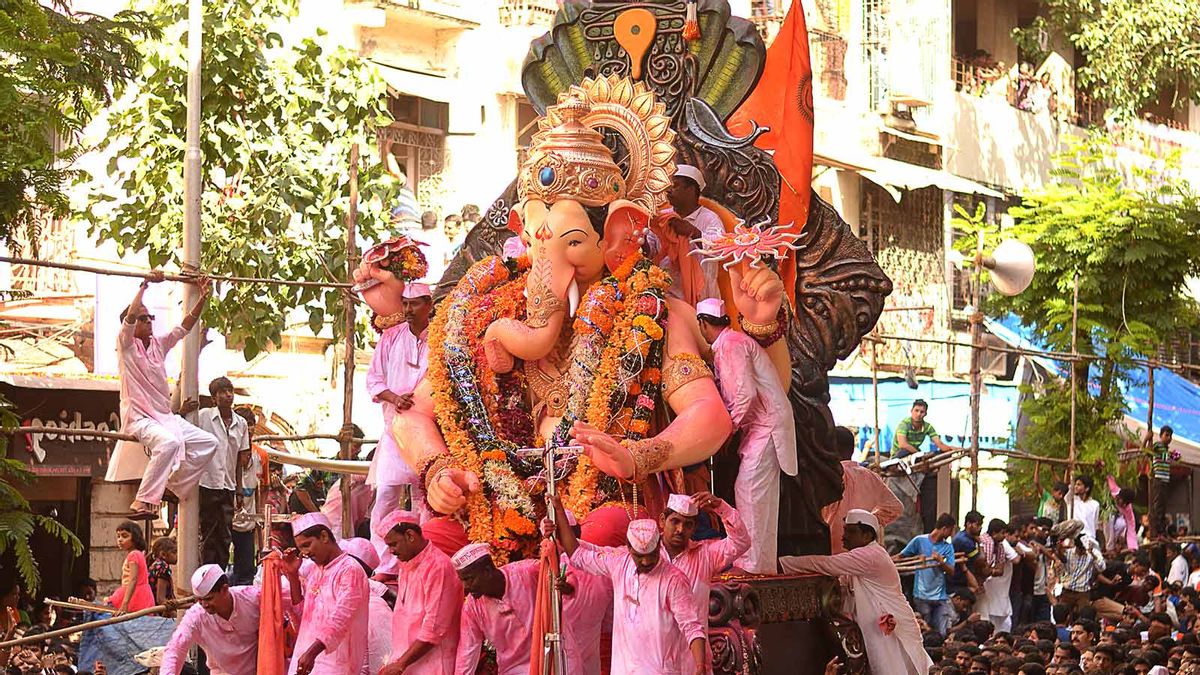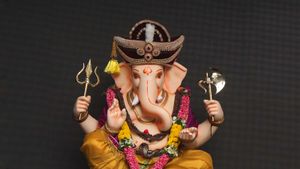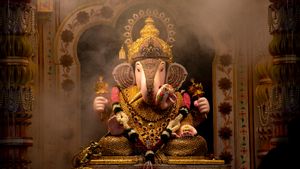Over the years, Mumbai’s Ganesh Chaturthi celebrations had increased in size and scale, with pandals competing with each other to put up the biggest, grandest show. For Lalbaugcha Raja, famed as the Navasacha Ganpati or the wish-fulfilling Ganesha, it meant longer serpentine queues—people waited in line for over 48 hours in a queue that was several kilometres long, for a glimpse of their beloved Ganpati. Due to the COVID-19 outbreak, the pandal had cancelled Ganeshotsav in 2020, but this year, they are back to celebrate the Ganpati festival in the traditional way, while adhering to the COVID-19 guidelines and restrictions.
The History of Lalbaug’s Wish-fulfilling Ganpati
Located in the commercial heart of Mumbai—Lalbaug in Parel—which was dominated by textile mills and single-screen cinema halls until a few decades back, Raja’s home wasn’t as we know it today.
As the story goes, back in the early 1900s, before the bustling markets came in, the area housed around 130 cotton mills and was called Girangaon or the ‘village of mills’. Around 1932, with industrialization, the market suffered losses and shut down affecting the livelihood of the vendors and fishermen community that lived here.
They turned to their favourite elephant-headed Ganesha, the god of new beginnings. Luckily for the community, they were granted a plot of land to construct a new market—the present-day Lalbaug market.
In 1934, the community decided to earmark a portion of the land to the annual Sarvajanik Ganesh Mandal (community celebration of the festival) and an idol of the elephant lord was established. He was dressed somewhat like a fisherman, as he belonged to this community, although over the years the Ganesha idol has seen many avatars. Bagging the title of Raja or king, he became the patron god of the locality.
Cut to today, the number of people drawn to him, with wishes and desires they hope Lalbaugcha Raja will fulfil, has grown into millions, piquing the interest of people from all over the world.
Eco-friendly 85th-anniversary celebrations

In 2018, the 85th year of Lalbaugcha Raja, the 20-feet tall Ganpati idol is not on his usual bejewelled throne. Lalbaug’s Raja has always been portrayed in a more human avatar, not the oft-seen pot-bellied Ganesha. In 2018, he took an eco-friendly avatar, sans any backdrop, sitting on a bare stone seat.
Augmented reality merged with the scene behind the larger-than-life Raja, highlighting the mandal’s eco-conscious efforts, urging devotees to respect the environment and its offerings – animals, trees, jungle, and waterfall.
Santosh Kambli, the murtikar or idol maker, cast Ganpati without the prabhavali (backdrop) and sinhasan (throne) – in a first-of-its-kind move in over 30 years. Embracing the plastic ban that was implemented in Maharashtra in June the same year, the materials used for Bappa’s decoration were made from papier-mache.
The making of Lalbaugcha Raja’s Boondi Laddus
Modak and laddus are Ganpati’s favourite food, but our beloved Raja has a thing for boondi laddus. “Bappa ko laddu pasand hai,” says Satish Shirsekar, director, Shree Bhawani Caterers, the man behind Lalbaugcha Raja’s preferred prasad.
The preparations in Lalbaug’s kitchen start 10-15 days prior to Bappa’s arrival. “Earlier, people bought modaks, fruits and other offerings from the stalls around. Then, six years ago, we began production of boondi laddus offered as Prasad by the Lalbaug mandal, and the demand has only grown.”
The laddu production takes a workforce of about 250 people—including 30 Maharajs and men and women who’re involved in the making to the selling of these melt-in-mouth boondi laddus. It takes four men to help mix the ingredients into a kadhai that holds 25 kg of boondi.
In 2015, the kitchen got a laddu-making machine that builds around 3,000 laddus in an hour. While the machine is no comparison to the love and warmth that goes into building laddus by hand, Shirseker says, “It helps us meet the growing demand for Bappa’s prasad.”
And mind you, these are no ordinary laddus. “The boondi is doused in ghee, flavoured with saffron essence, a liberal helping of cashew nuts, raisins, cardamom and nutmeg powder is added to the boondi before building the laddus,” informs Shirsekar. In 2018, Lalbaugcha Raja’s laddus were distributed in paper bags. The soft, sugary boondi laddus carry the love and spirit of Bappa.
Disclaimer: The details mentioned throughout this blog are sourced from publicly accessible platforms. At Zeezest, we intend to share factual and verified information. Should there be any inconsistencies or variances in the information provided, please understand that these are entirely unintentional and not meant to mislead.




